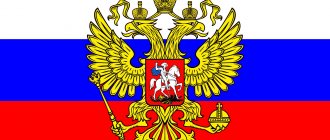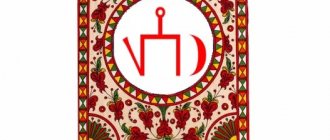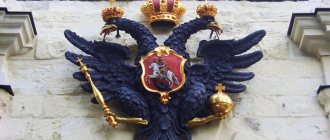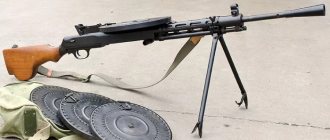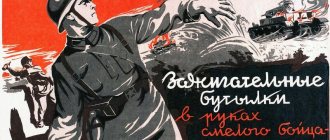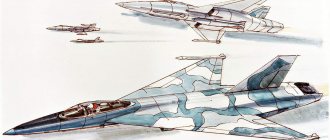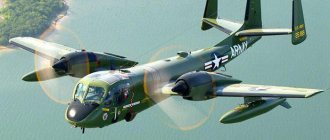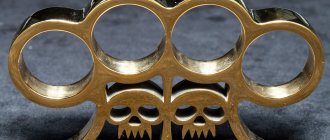The exact date of birth of the double-headed eagle as a heraldic symbol of Rus' is not known. For the first time, his image appears on the so-called large “hanging” red wax seal of Ivan III, intended for sealing documents. On the other side of this seal there was an image of a “rider” piercing a snake - a symbolic image of the patron saint of the Moscow princely house, George the Victorious. It is clear that the time reference in this case is conditional - we can only say that the earliest of the four impressions of this seal that have reached us seals the document of 1497, but when the stamp was created, and even more so when the decision was made to use a new state symbol remains a mystery. But many years later, on November 30, 1993, the first President of Russia, Boris Yeltsin, signed a decree on the return of the double-headed eagle as the official state emblem of our country, and one certainly cannot argue with this dating. The iz.ru portal looked into the complex fate of the sovereign symbol and the history of its appearance in Rus'.
Brief description and meaning of the symbols of the coat of arms of Russia
This state insignia is a red heraldic shield, in the middle of which there is a golden double-headed eagle. The bird holds an orb in its left clawed paw, and a scepter in its right.
On each of the heads there is a crown, and on top there is another, larger one. All three royal decorations are connected by a gold ribbon.
In the center of the shield, on the eagle’s chest, there is another red cloth. It depicts a plot familiar to every Russian: St. George the Victorious kills a snake.
There are many icons and paintings illustrating this legend. This is the most recognizable image of the saint. On the emblem he is represented as a silver rider on a silver horse, wearing a blue cloak. A monster under the hooves of a black horse.
Shield as the basis of the coat of arms
The main figure and all images of the coat of arms are placed in the field of the shield. The shield serves as the basis of any coat of arms. This tradition dates back to the era of chivalry, when knights painted their distinctive marks on their armor.
The shield is an important heraldic element, without which there is no coat of arms . Shields vary in shape. There are German, English, rhombic, square and other forms of shields.
In Russian heraldry, the French shield is most often used: a rectangle, the lower edges of which are rounded, and in the middle of the lower part there is a slight point.
The shield has been a symbol of protection since ancient times . In the coat of arms of Russia, the color of the shield is red.
It symbolizes courage, bravery, blood shed for freedom and happiness, love for the Motherland. This is the favorite color of the Russian people. We begin the story about the coat of arms with its heraldic basis.
How were the symbols on the coat of arms of the Russian Federation formed and what do they mean?
Today, heraldry is an auxiliary branch of historical science. The emblems of countries, along with annals and chronicles, represent the most important historical evidence.
In Western Europe, during the times of chivalry, every noble family had a symbol that was inherited from generation to generation. It was present on the banners and was a sign of distinction by which a representative of the clan was recognized both on the battlefield and at the feast. In our country, this tradition has not been developed. Russian soldiers carried embroidered images of the great martyrs, Christ or the Virgin Mary into battle. The Russian heraldic sign originates from princely seals.
What do the main elements of the Russian coat of arms mean: St. George the Victorious
On the princely seals there were the patron saints of the rulers and an inscription indicating who owned the symbol of power. Later, a symbolic image of the head began to appear on them and on coins. Usually it was a horseman holding some kind of weapon in his hand. It could be a bow, sword or spear.
Initially, the “rider” (as this image was called) was not a sign only of the Moscow principality, but after the unification of lands around the new capital in the 15th century, it became an official attribute of the Moscow sovereigns. He replaced the lion who defeats the snake.
What is depicted on the state emblem of Russia: a double-headed eagle
It should be noted that this is a popular symbol, which is used as the main one not only by the Russian Federation, but also by Albania, Serbia, and Montenegro. The history of the appearance of one of the main elements of our emblem goes back to the times of the Sumerians. There in this ancient kingdom he personified God.
Since antiquity, the eagle has been considered a solar symbol associated with the spiritual principle and liberation from bonds. This element of the Russian coat of arms means courage, pride, desire for victory, royal origin and the greatness of the country. In the Middle Ages it was a symbol of baptism and rebirth, as well as of Christ in his ascension.
In Ancient Rome, the image of a black eagle was used, which had one head. Such a bird was brought as a family image by Sophia Paleologus, the niece of the last Byzantine emperor Constantine, whom Ivan the Terrible’s grandfather, Ivan III, known as Kalita, married. In Russia, the history of the famous double-headed eagle begins during his reign. Together with his marriage, he received the right to this symbol as a state emblem. It confirmed that our country had become the heir of Byzantium and began to claim the right to be a world Orthodox power. Ivan III received the title of Tsar of All Rus', ruler of the entire Orthodox East.
But during the time of Ivan III, the official emblem in the traditional sense still did not exist. The bird was featured on the royal seal. It was very different from the modern one and looked more like a chick. This is symbolic, since Rus' at that time was a young, fledgling country. The eagle's wings and beak were closed, the feathers smoothed.
After the victory over the Tatar-Mongol yoke and the liberation of the country from centuries-old oppression, the wings flutter open, emphasizing the power and might of the Russian state. Under Vasily Ioanovich, the beak also opens, emphasizing the strengthening of the country’s position. At the same time, the eagle developed tongues, which became a sign that the country could stand up for itself. It was at this moment that the monk Philotheus puts forward a theory about Moscow as the third Rome. Spreading wings appeared much later, in the early years of the Romanov dynasty. They showed neighboring hostile states that Russia had perked up and rose from sleep.
The double-headed eagle also appeared on the state seal of Ivan the Terrible. There were two of them, small and large. The first was attached to the decree. There was a rider on one side and a bird on the other. The king replaced the abstract horseman with a specific saint. St. George the Victorious was considered the patron saint of Moscow. This interpretation would finally be consolidated under Peter I. The second seal was applied and made it necessary to combine two state symbols into one.
This is how a double-headed eagle appeared with a warrior on a horse depicted on its chest. Sometimes the rider was replaced by a unicorn, as a personal sign of the king. It was also an Orthodox symbol taken from the Psalter, like any heraldic sign. Like the hero defeating the snake, the unicorn signified the victory of good over evil, the military valor of the ruler and the righteous strength of the state. In addition, this is an image of monastic life, the desire for monasticism and solitude. This is probably why Ivan the Terrible highly valued this symbol and used it along with the traditional “rider”.
What do the elements of the images on the coat of arms of Russia mean: three crowns
One of them also appears under Ivan IV. It was on top and was decorated with an eight-pointed cross as a symbol of faith. The cross has appeared before, between the heads of birds.
During the time of Fyodor Ioanovich, the son of Ivan the Terrible, who was a very religious ruler, it was a symbol of the passion of Christ. Traditionally, the image of a cross on the coat of arms of Russia symbolizes the country's acquisition of ecclesiastical independence, which coincided with the reign of this tsar and the establishment of the patriarchate in Rus' in 1589. The number of crowns varied at different times.
Under Tsar Alexei Mikhailovich there were three of them, the ruler explained this by the fact that then the state absorbed three kingdoms: Siberian, Kazan and Astrakhan. The appearance of three crowns was also associated with the Orthodox tradition, and was interpreted as a sign of the Holy Trinity.
It is currently known that this symbolism on the coat of arms of the Russian Federation means the unity of three levels of government (state, municipal and regional), or its three branches (legislative, executive and judicial).
Another version suggests that the three crowns mean the brotherhood of Ukraine, Belarus and Russia. The crowns were secured with ribbon already in 2000.
What does the coat of arms of the Russian Federation mean: scepter and orb
They were added at the same time as the crown. In earlier versions, the bird could hold a torch, a laurel wreath, and even a lightning bolt.
Currently, an eagle holding a sword and a wreath is on the banner. The attributes that appeared in the image personified autocracy, absolute monarchy, but also indicated the independence of the state. After the 1917 revolution, these elements, like the crowns, were removed. The Provisional Government considered them a relic of the past.
Seventeen years ago they were returned and now adorn the modern state insignia. Scientists agree that in modern conditions this symbolism of the coat of arms of Russia means state power and the unity of the state.
Creation of a coat of arms
Ivan III (1440-1505) inherited from his father Vasily the Dark the coat of arms placed on the seal. It was a lion (symbol of the Vladimir principality) killing a snake. For the new country, which united several Russian principalities and finally got rid of the control of the Golden Horde, at the end of the 15th century, new symbols were chosen - St. George the Victorious and a double-headed eagle crowned with two crowns with open and raised wings.
The eagle is a symbol of strength and invincibility. Perhaps the idea came from the wife of Ivan III, Sophia Paleologus - she had every right to use this sign as the daughter and heir of the last despot of the Morea, who fell after the Turkish invasion. In addition, the double-headed eagle was on the coat of arms of the strongest empire in Western Europe at that time - the Habsburg Empire. With its new coat of arms, Rus' seemed to show that it was worthy to participate in European politics on an equal basis with the most powerful states. Soon, a golden eagle on a red background appeared on the walls of the Faceted Chamber of the Kremlin and on the grand ducal seal.
What did the coat of arms of the Russian Empire mean under Peter I?
After coming to power, the first Russian emperor decided that the double-headed eagle should not just decorate certain official papers, but also become a full-fledged symbol of the country. He decided that the bird should become black, like the one that was on the banners of the Holy Roman Empire, of which Byzantium was the heir.
On the wings were painted the signs of local large principalities and kingdoms that were part of the country. For example, Kyiv, Novgorod, Kazan. One head looked to the West, the other to the East. The headdress was a large imperial crown, which replaced the royal one and hinted at the specifics of the established power. Russia asserted its independence and freedom of rights. Peter I chose this type of crown several years before he proclaimed the country an Empire and himself emperor.
The Order of St. Andrew the First-Called appeared on the bird's chest.
Until Nicholas I, the official emblem of the country retained the form established by Peter I, undergoing only minor changes.
The meaning of the colors on the coat of arms of Russia
Color, as the brightest and simplest sign, is an important part of any symbolism, including state symbols.
In 2000, it was decided to return the eagle to its golden color. It is a symbol of power, justice, the wealth of the country, as well as the Orthodox faith and Christian virtues such as humility and mercy. The return to the golden color emphasizes the continuity of traditions and the state’s preservation of historical memory.
The abundance of silver (cloak, spear, horse of St. George the Victorious) indicates purity and nobility, the desire to fight for a righteous cause and truth at any cost.
The red color of the shield speaks of the blood that was shed by the people in defense of their land. It is a sign of courage and love not only for the Motherland, but also for each other, and emphasizes that many fraternal peoples coexist peacefully in Russia.
The snake that the rider kills is painted black. Heraldry experts agree that this symbol on the coat of arms of the Russian Federation means the country’s constancy in trials, as well as memory and grief for the dead.
Hammer and sickle
For five centuries, the double-headed eagle was associated with autocracy and was unacceptable as a symbol of Soviet Russia. In June 1918, a new Constitution was adopted, and with it the coat of arms. The red shield, hammer and sickle, rising sun and red star were supposed to symbolize the ideology of the Communist Party, as well as the inspiring inscription on the ribbon “Workers of all countries, unite.”
The coat of arms of the RSFSR existed for 75 years, outliving the USSR by two years. In 1992, it was changed for the last time, replacing the abbreviation “RSFSR” with “Russian Federation”, but the fate of the hammer and sickle had already been decided - back in 1990, the Government Commission began developing a new symbol.
